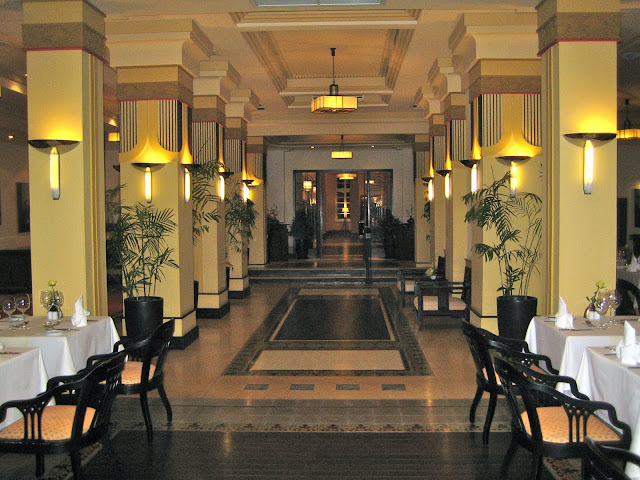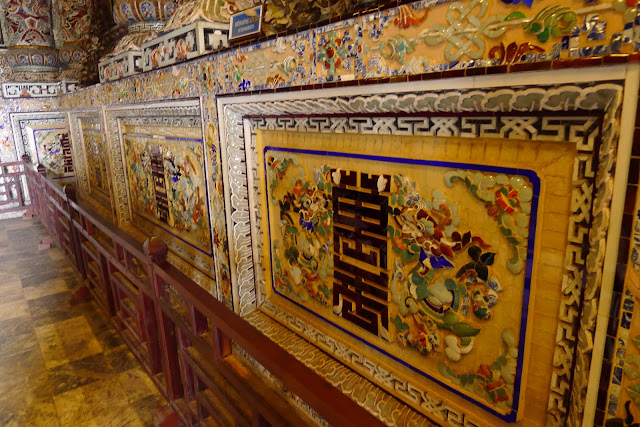Hue is located in the center of Vietnam, on the banks of the Perfume River. It is well known for its monuments and architecture. The population of Hue is about 340,000.
We selected to visit this city for several reasons. Hue has been one of Vietnam's cultural, religious and educational centers. It served as the political capital from 1802 to 1945 under 13 emperors of the
Nguyen Dynasty. This is the gate to the Citadel, the seat of the emperors and the government.
The second reason why we came here is that this city was the site of the largest battle of the Vietnam War. Major physical damage was suffered by this once pristine Imperial city.
The third reason was that there are several opulent tombs of the Nguyen emperors located here.
Knowing what I know now, this should have been the #1 reason to pay a visit to Hue. This is the enchanting La Residence Hotel, one of the top 3 hotels in all of Vietnam. Built in 1930 as the French
Governor's residence, this mansion was converted into a boutique
hotel in 2005. Notice the two modern wings of bedrooms added to the original building.
I fell in love with this hotel. It made my all-time top 3 hotel list: #1 - Incaterra in Machu Picchu, #2 - Isandlwana Lodge in Zululand, South Africa, #3 - La Residence.
This is the huge salt water pool, so refreshing after a long hot day in the Vietnam sun.
The main building is the centerpiece of the hotel. The distinctive art deco design is reminiscent of colonial Indochina.
Impeccable decorating. I spent an hour looking at every piece of furniture and paintings.
122 rooms with terraces overlooking the Perfume River and the Citadel.
My dream is to spend a week here with my favorite girl, Kim Basinger.
Check out the business / internet room. It also provided free WiFi in all the rooms.
How about this, an art gallery.
Look at that floor, the ceilings, the light fixtures, the chairs, etc.
Everything was tasteful and set to perfection.
And the dining here at the 5-star the Le Parfum Restaurant is the only fine dining venue in Hue.
What can I say!! This hotel has set the standard of luxury for the ancient city of Hue and I luckily fell right in its lap.
Back to reality. The seat of the Nguyen emperors was the Citadel, which occupies a large walled area on the north side of the Perfume River. This is Cot Co or Flag Tower. At a height of 120 feet, it dominates the Hue skyline since 1809.
These 5 massive bronze cannons were symbolic as protection for the capital.
Each weapon is said to represent the 5 elements - earth, metal, wood, water and fire.
Inside the Citadel walls was a forbidden city where only the emperors, concubines and those close enough to them were granted access. The punishment for trespassing was death. Construction of this moated Citadel began in 1804 by the emperor Gia Long. In 1993, it was designated as a World Heritage site.
This is the majestic main gate, Ngo Mon Gate. Massive stone slabs
form the foundation upon which rests an elaborate watch tower.
Inside the gate is another moat and the living quarters of the emperors.
Thai Hoa Palace is the grand palace of the emperors.
The Nguyen family ruled Vietnam for 143 years. They lived a life of luxury and opulence.
When the French arrived, Catholic missionaries and European lifestyle added new ingredients to the cultural stew of Vietnam.
At one time, this place was an elegant complex, where beautiful palaces and temples coexisted with massive ramparts, bastions and moats. On January 31, 1968, the longest and bloodiest battle of the Vietnam War was fought here (Tet Offensive). North Vietnamese and Viet Cong forces seized the old imperial capital for 25 days. Only after massive bombing did the Americans finally root out the enemy. However, as you can see, major damage was suffered by this once pristine palace.
The battle took a toll of some 142 American lives but thousands of Hue citizens with ties to the U.S. were rounded up and executed by the communists.
Today, little of the forbidden city remains, but recent restoration work has restored some of the Citadel's lost grandeur.

The North Vietnam communists have always disliked the city of Hue because of its ties with the ruling Nguyen dynasty. For that reason, reconstruction is a slow process here.
An elephant ride for the tourists.
Hue and the Perfume River have been the topic for many songs and works of literature. Because the city was built around the river, the lives of the people often revolve around the famous river.
Very unique design on these boats.
Three miles west of the Citadel, is the 7-story octagonal tower of the Thieu Mu Pagoda.
The gardens here are well manicured.
It also houses a Buddhist monastery.
I was in for quite a surprise when I found a famous car in an open garage in the rear of the monastery. This was the car that drove monk Thich Quang Duc to downtown Saigon on June 11, 1963. There on a busy street, he poured gasoline on himself and self immolated himself in protest against the Diem regime.
Images of this horrific event were shown all over the world, provoking widespread shock and outrage. I still remember discussing this event as a young second-year teacher at Banning High. To see this car was one of today's highlights.
The last site we visited was the tomb of Khai Dinh. There are 7 royal tombs in the vicinity of Hue. Khai Dinh ruled here from 1916 -1925. He was the last Emperor to be buried in a royal tomb at Hue.
At the entrance, you climb 37 steps with dragons as side walls.
The tomb makes use of concrete, combining European and Vietnamese architectural styles in a unique fusion.
Built into the side of a hill, the tomb rises through 3 levels.
In the temple at the summit, is his grave and alter.
The most noticeable characteristic of the tomb is the glassy and ceramic mosaics, a masterpiece of Vietnamese artisans.
His alter and grave. A golden effigy of the Emperor seated on his throne under a magnificent canopy.
Here is a bronze statue of the Emperor Khai Dinh cast at Marseilles in 1922.
Khai Dinh suffered poor health and became a drug addict. He eventually died of tuberculosis at age 40.
His son, Bao Dai became the Emperor after his death. Soon after, WW II and the communist takeover ended the long Nguyen dynasty.
Hue was a brief, worthwhile stop for the 3 of us. The La Residence Hotel made it for me. I left depressed seeing the devastation at the Citadel. Just another example of my theory about war, nobody wins, and everybody loses. Our next stop is the great city of Saigon. TO BE CONTINUED .......................


























































Marvelous, thank you for sharing!
ReplyDelete